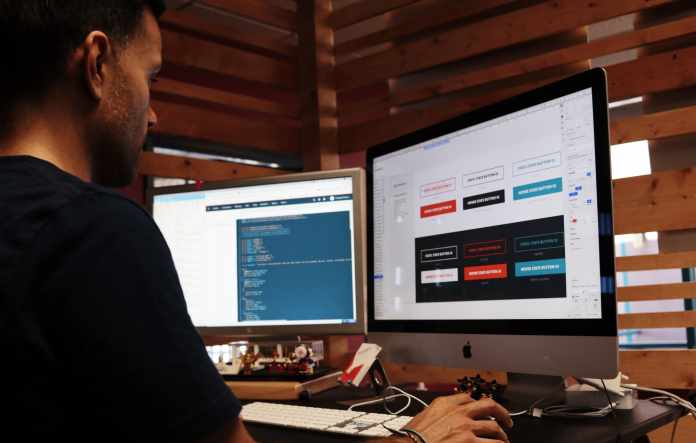7 Landing Page Optimisation Tips For Better Conversion. If your prices are competitive, the offers are narrowly targeted, the landing page has been tested hundreds of times, and the conversion rate is so high that it’s hard to believe. Leads flow to the sales department, converting them into monetary units. You are a marketing genius (and something tells you that you have every right to call yourself that).
But then you suddenly wake up and realise that your landing page has not been optimised since the day it was created, and all the potential profit – like a leaky ship – is slowly sinking to the bottom.
Landing page conversion depends on many details. Each of them can either “kill” the advertising budget, or bring incredible profits.
Often simple, even nondescript, landing page designs sell better than cool designs. However, there are a number of basic principles. In 9 out of 10 cases, they help increase conversions.
Improving landing page conversions is a case where details are everything. In order for as many visitors as possible to complete the target action, you need to take into account and test many factors. Let’s consider how to increase the conversion of your landing page using text, design and psychological techniques.
Table of Contents
1. Relevant title and unique selling proposition in it
When a user navigates from an ad to a landing page, they should see that your offer matches their needs. This is not just the product he needs, but also the conditions he needs (for example, with installation, in instalments, on credit).
Let’s say we have a group of requests:
Car loan Sydney
Car in instalments
Car loan without a down payment
Users follow these requests and see the header:
“Get a loan for a car in 2 hours on favourable terms. Rates from 12%. Drive now, pay later!“
The principle of relevance worked: “Yes, I am in the right place.”
The offer on the landing page must be different from the offer of competitors. Price, service or price + service. The price difference is becoming less and less effective – in most cases, the market does not allow much dumping. An exception may be a time-limited promotion.
In terms of service, there are more opportunities to stand out: delivery, installation and maintenance, warranty, test drive, estimate calculation.
For example: “Car repair and painting with a guarantee” or “Clothes of European brands with free shipping”.
2. Tidy up your header
Most people read the information in a Z-pattern. When they open your landing page, they will unconsciously skim over the header. Therefore, it is wise to place important elements there.
What can you place in the header:
-high-quality logo;
-description;
-tagline;
-clickable contacts – phone, mail, instant messengers, but not social networks (otherwise the visitor may leave the landing page prematurely);
-working hours;
-navigation menu;
-a button with a target action;
-fields as needed – to select a city, change the language, search, log into your account.
All elements do not have to be present – proceed from the specifics of the business and the needs of the target audience.
Let’s dwell on the most important ones:
-the descriptor explains to the person where he got to – so that the person immediately finds out what is being offered to him.
-the menu helps you find the information you need without any problems.
-a button and a clickable phone number- the ability to quickly contact you and place an order. Especially convenient from a mobile phone.
3. Photo of a real customer on the first screen
A lot has been said about the dangers of free (stock) photos for landing page conversion. The bottom line is that the visitor feels not just fake, but a disdainful attitude towards himself. Even if the product is great, trust, and with it, conversion drops dramatically.
Trust grows when the image turns into social proof.
You need a photo of real users of the product. In this case, an important element is a quote from a review.
Tests show that a unique photo of a person on the first screen causes 3 times more credibility on the landing page compared to other options. So, even if it sounds irrelevant to you, make sure that you have a proper photo of a real user on your landing page.
4. Post reviews
Positive reviews give people confidence in the legitimacy of a business. Word of mouth is one of the most powerful marketing tools, and reviews are the foundation of social proof. Most companies post reviews that are too generic or fake to inspire customer confidence. Something like the following set: “Great job” – Mark A., “Thank you, I will order more!” – Victoria K., “Thanks to your advice, we earn twice as much!” – Sara R. and the most popular is “Thank you.” – John B.
Who is Mark A.? Or where did this Sara R. come from?
Reviews should reflect on how the customer has benefited. The more detailed the review, the more “human” it is. The more “human” – the more believable.
But be careful. The easiest, easiest and most affordable way is to write reviews yourself or hire someone. Beware that the photo of your fake client is not posted next to similar reviews on competitors’ websites.
5. A compelling call to action
Takeover bullets do not work by themselves without a final element – a call to action. Using a regular verb can significantly increase conversions. As in the following example:
Just replacing “Order Information” with “Get Information” contributed to an increase in form conversion. Just one word!
Compared to the banal “Leave a request”, “Find out more”, etc. the appeal in the form of the ultimate benefit affects users more strongly. As in the previous example: “I want to return the money.” More options: “Increase sales”, “Become an investor”, “Try for free”.
6. Test the colour, shape and size of buttons
The colour, shape and size of buttons are some of the main points in the psychology of conversion, according to experts from a web design company in Sydney. The call-to-action button is the number one element of your landing page that provides a high CTR (click-through rate). Therefore, it is very important to make sure that it performs is as good as possible.
A few important points:
Colour: The colour of the button should contrast with the main colour scheme of the page.
Orange stands out well against blue, red contrasts well with green, and purple is the absolute opposite of yellow.
Orange has been proven to be the most clickable colour – a symbol of energy and warmth that brings the greatest benefits to marketers as it pushes the customer to buy. On the other hand, red creates a sense of urgency and, in principle, can be as effective as orange. But you shouldn’t rely on assumptions: testing will help to determine exactly which colour – orange, red, or even light green – will be the best option for your landing page.
Shape: Sometimes rectangular buttons are less convertible than rounded buttons.
The reasons for this are as follows:
Rounded corners are better visually perceived.
Sharp corners are a threat signal ingrained in the minds of people. As funny as it sounds, the same goes for the buttons.
Sharp corners also act as directional cues (such as arrows) to distract the user’s attention from the button.
To avoid possible problems with rectangular, square or triangular buttons, a combination of different shapes can be used.
Size: Of course, button size also affects your conversion rate. Testing the size of the CTA is the best way to verify this. (Hint: Big buttons usually win.)
7. Time limit
Based on the well-known principle of scarcity, described by Dr Cialdini in The Psychology of Influence, in international marketing, special offers with deadlines have proven their worth many times over.
One problem: like any strong technique, the time limit began to be used thoughtlessly, as a manipulation of the consumer. Therefore, take into account 3 important points:
1) Deadline is only justified for truly valuable and accurate proposals. Getting into the need of the target audience should be such that the potential client thinks “I would be a complete fool if I do not take advantage of this offer.”
2) Use as many arguments as possible on the landing page to remove objections. The time limit is not effective in itself, but as an “appendage” to a variety of arguments.
3) Explain why you are running the promotion and what will happen after the deadline. What benefits the user will miss if they skip the offer. Just do not stoop to the market trick in the spirit of “either now or never.”
Conclusion
As you can see, there are many ways to increase the effectiveness of your landing page with the help of text, design, and psychological techniques. The most surprising thing is that none of the basic principles of landing page conversion works 100%. There is always an example that will refute numerous studies. Remember to keep an eye on the site and test it regularly. So test, test, and test your pages again.












